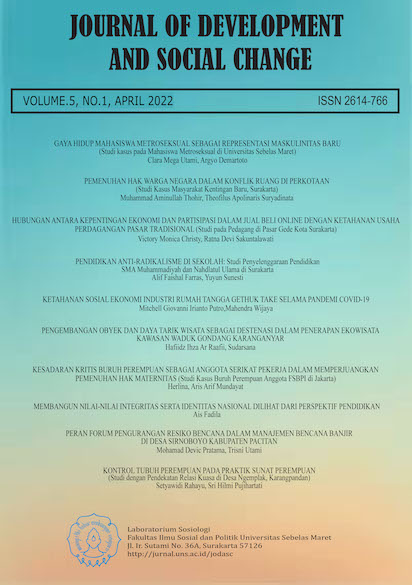KAJIAN KEHIDUPAN SOSIAL PENGEMIS DI KOTA SURAKARTA
Abstract
The objective of this study is to examine the social life of beggars on the front stage and on the back stage residing in Joyotakan Village, Serengan, Surakarta, by using Dramaturgy Theory by Erving Goffman. This qualitative research uses the naturalistic inquiry method. In addition, the sampling technique uses purposive side and snowball sampling. Furthermore, the research informants taken are those who work as beggars. Data collection uses observation and in-depth interviews. The validity of the data uses triangulation of sources with the former management of Social Study Agency (LSK) Bina Bakat, and the head of the local neighborhood. The data analysis technique uses interactive analysis model from Miles and Huberman.
The results of the present research show that on the front stage, the actors act as Me, in order to be accepted by the audience. The setting of begging is done on the vital objects of the city such as the Great Mosque, PGS-BTC area, Tugu Lilin area, Jebres Police Station, Matahari Singosaren, Indomaret Tipes, and at Sebelas Maret University (UNS) and campus graduation events, and Surakarta Muhammadiyah University (UMS). In terms of appearance, they wear several attributes in the form of religious attributes (veils and prayer beads), supporting attributes (children, sling bags, plastic cups, and fingers), and general attributes (shirts, negligee, jackets, sandals, and clean clothes). They play sound, gesture, and expression as begging manner.The conclusion of the research is that theoretically the actor will play the role of Me on the front stage. However, in reality, I can also be seen when actors face disturbance in a show. The disturbance is in the form of rejection of the actors' presence; even the actors get a discrediting stigma from the audience, so that I appears as a response to the disorder. In the actors' social life of on the back stage, their human self will appear as I. However, the actors sometimes become Me when they have to take part in social activities that become the norm in society.
Full Text:
PDFReferences
Adi, Isbandi Rukminto. 2005. Kemiskinan Multidimensi. Jurnal Makara Sosial Humaniora, Vol. 9, No.1 2005.
Anipa, Putri Junita. 2015. Persepsi Pengemis tentang Perda no 12 tahun 2008. Jurnal Online Mahasiswa Fisip, Vol. 2 No. 2 Oktober 2015.
Anonim. 2018. Profil Kemiskinan di Indonesia Maret 2018. https://www.bps.go.id/website/images/Kemiskinan-Maret-2018-ind.jpg (diakses 3 Agustus 2019 pukul 21.00).
Mansyur. 2014. Problematika Urbanisasi. Jurnal Al-Munzir, Vol.7, No.1 2014.
Mubyarto, 1983. Strategi dan Pembangunan Pedesaan. Yogyakarta: UGM.
Nuraeni, Heni Gustini. 2015. Komodifikasi Keagamaan di Kalangan Pengemis di Kampung Pengemis Kota Bandung. Jurnal Dakwah, Vol.16, No.2 2015.
Poloma, Margaret M. 2003. Sosiologi Kontemporer. Jakarta: PT. Raja Grafindo Persada.
Ritzer, George. 2010.Teori Sosiologi Modern. Jakarta: Kencana Prenada Media Group.
Suneki, Sri dan Haryono Haryono. 2012. Paradigma Teori Dramaturgi Terhadap Kehidupan Sosial.Jurnal Ilmiah CIVIS, Vol. 2, No.2 2012.
Widjaja. H.A.W. 2000. Ilmu Komunikasi Pengantar Studi. Jakarta: Rineka Cipta.
DOI: https://doi.org/10.20961/jodasc.v2i1.41654
Refbacks
- There are currently no refbacks.




